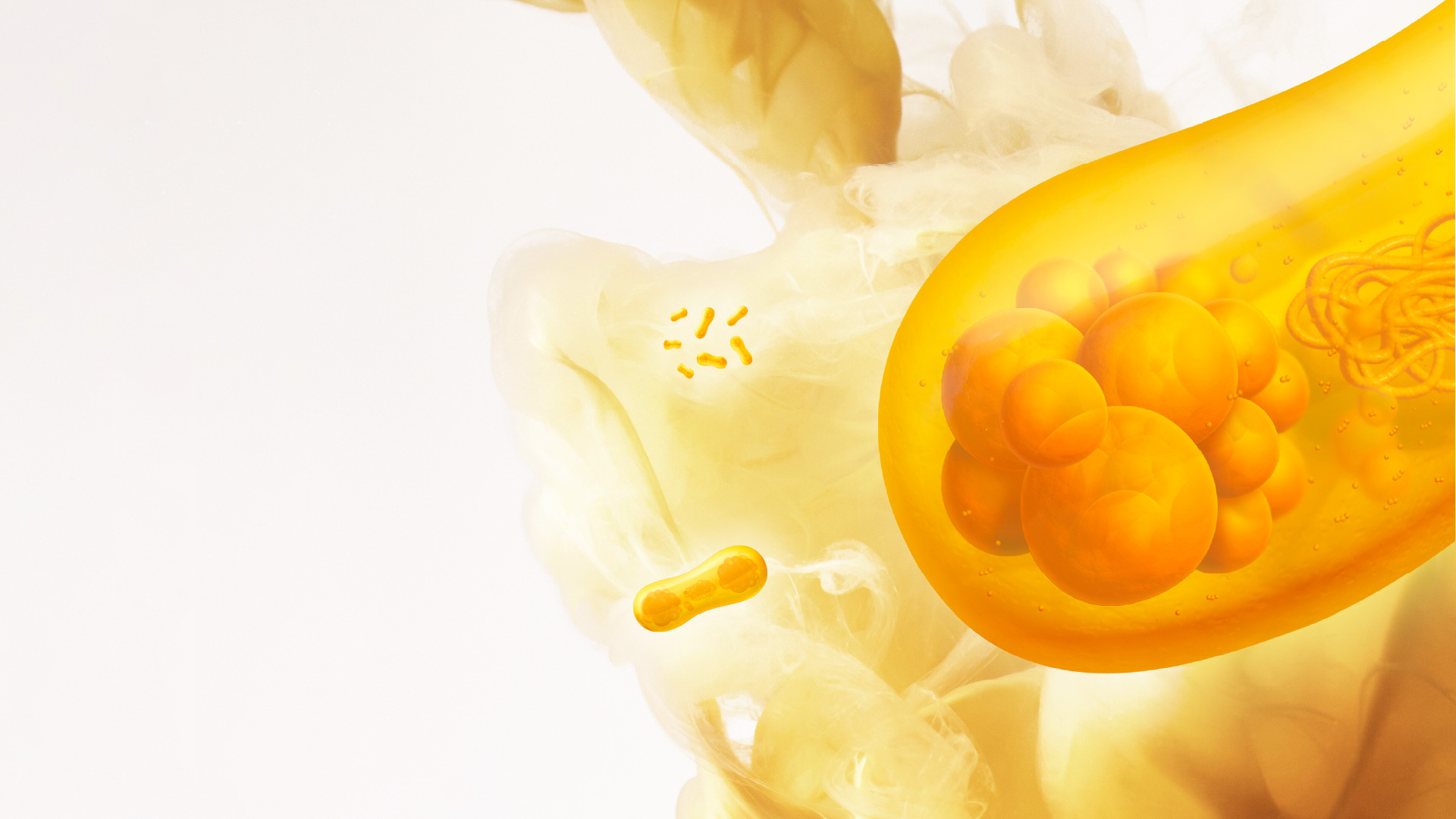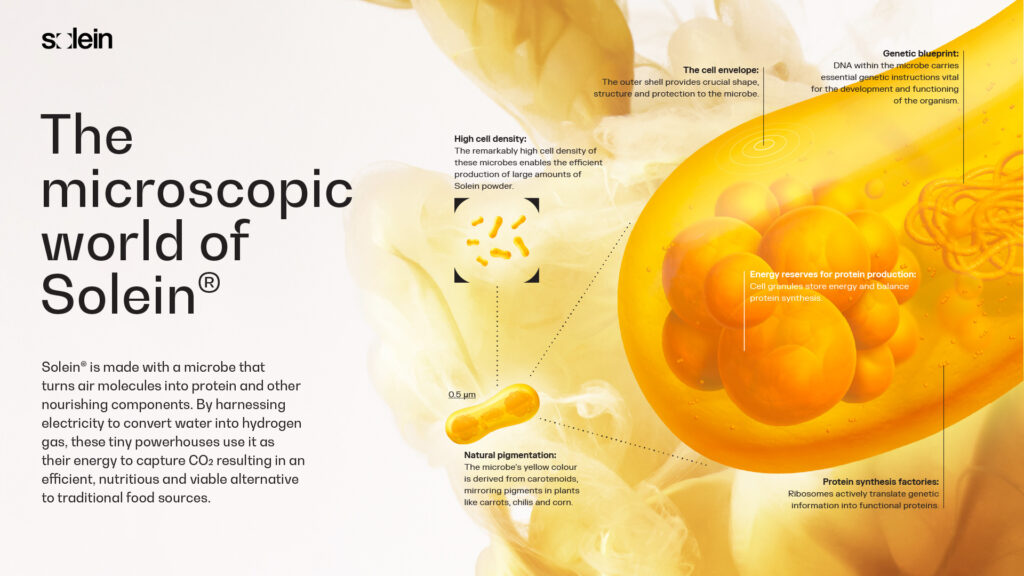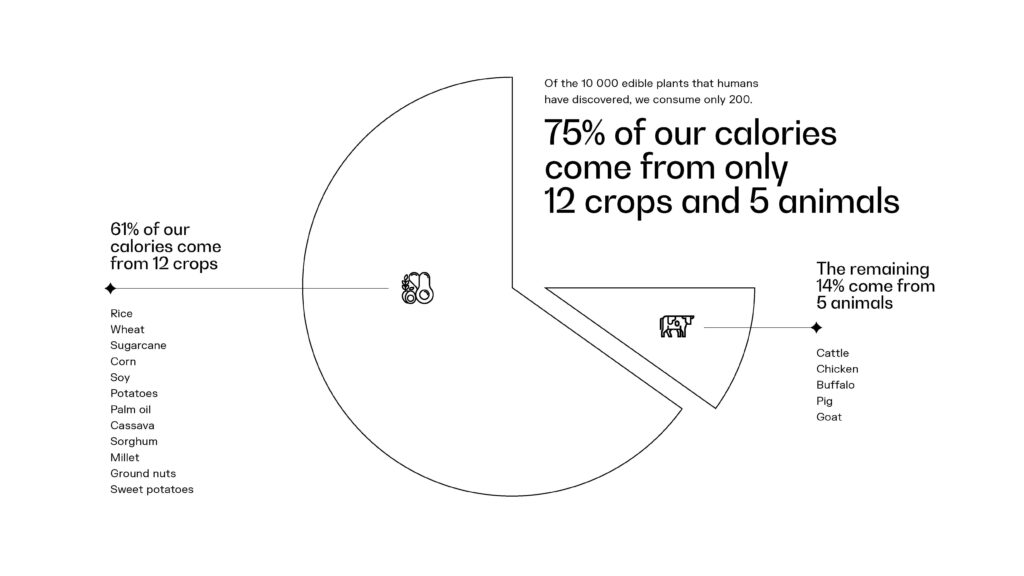Solein® transforms ancient microbes into the future of food

Solein is a protein grown out of thin air. But what is at the heart of this special, novel ingredient? We explore Solein’s roots on the microbial level to understand how the tiniest, invisible bounty of nature paired with a modern bioprocess are helping us redefine the future of sustainable food production.
The emergence of Solein in the realm of sustainable nutrition has captured the public imagination, spearheaded by the evocative slogan “protein out of thin air.” This phrase, while conjuring images of a futuristic world where food materialises from the atmosphere, simplifies a more complex scientific reality.
Solein is essentially dried microbes created by producing and dehydrating hydrogen-oxidising bacteria (HOB). Microbes fed with thin air. This distinction is important, as it underlines Solein’s unique method of protein synthesis.
At its core, Solein is composed of tiny single-celled organisms. Unlike traditional yeast, which relies on sugar as its feedstock, Solein utilises gases – specifically, hydrogen and carbon dioxide. These elements are not only abundant but also underutilised resources.
The HOB are nature’s perfect factories, converting gaseous elements into life-sustaining protein. While there are various types of hydrogen-oxidising bacteria, the specific strain used in Solein is optimal for efficient protein synthesis. These bacteria harness a process known as chemosynthesis, where chemical reactions, rather than light (as in photosynthesis), provide the energy needed for growth. In Solein’s case, the bacteria oxidise hydrogen – a process involving the removal of electrons from the hydrogen molecules. This reaction releases energy, which the bacteria use to fix carbon dioxide, transforming it into organic compounds, including proteins.

What sets Solein apart is its minimal reliance on natural resources compared to conventional agricultural methods. Traditional plant-based protein sources require significant amounts of water, land, and fertilisers, not to mention the extensive agricultural infrastructure. Solein can be cultivated in bioreactors, controlled environments where their growth conditions – temperature, pH, gas concentrations – are meticulously managed. This process eliminates the need for arable land, drastically reduces water usage, and circumvents the need for chemical fertilisers made with fossil fuels.
Solein’s ancient roots: the dawn of microbial nutrition
“Solein is more than a mere product; it represents the seamless integration of nature’s ancient processes with the pinnacle of modern technology,” Susanna Mäkinen, Head of Biology at Solar Foods, states.
The microbe at the heart of Solein’s story was plucked from the rich biodiversity of Finland’s nature. Little did it know that it would be the ancestor of trillions of similar yellow cells.
Microbes are the seeds of life. These invisible yet omnipresent life forms have been an integral part of Earth’s ecosystems since life first stirred in the ancient oceans. These microorganisms, far predating the emergence of plants and animals, have been the unsung heroes and foundational blocks of life as we know it.
The relationship between humans and microbes is one deeply rooted in history. Long before the dawn of civilization, our ancestors were unwittingly harnessing the power of these microscopic beings. The fermentation of wine and yoghurt, the leavening of bread – these were our early forays into biotechnology, where microbes were the unseen workers. Microbes were unknowingly employed over millennia to transform basic ingredients into foods with enhanced taste, texture, and nutritional value.
In the ancient world, fermentation was akin to a form of alchemy. Yeast was used to convert the sugars in grains and fruits into alcohol and carbon dioxide, giving rise to some of humanity’s oldest beverages – wine and beer. Similarly, the art of bread-making was revolutionised by the discovery of yeast’s ability to cause dough to rise, creating the soft, airy texture that has become a staple across cultures. In dairy products like yoghurt and cheese, lactic acid bacteria played a crucial role, not only in flavour development but also in preserving these foods in times when refrigeration was non-existent.
These early applications of microbes in food production were more than mere culinary experiments; they were integral to the survival and development of human societies. Fermented foods provided essential nutrients, were safer to consume due to their lower pH inhibiting pathogen growth, and had longer shelf lives – crucial advantages for our nomadic ancestors and growing civilisations
Solein’s uniqueness in the modern market
Solein stands out in the emerging market of alternative proteins of plant-based meats, lab-grown meats and glucose-fed mycoproteins. It is not derived from plants, animals or fungi nor does it require extensive resources like sugar or other solid feedstocks, like many other microbial proteins do. Its production is based on a simple yet revolutionary concept: separating water into hydrogen and oxygen with electricity and growing microbial protein with those gases and CO2. This not only sets it apart from other protein sources but also minimises its environmental footprint.
“Solein represents a transformative shift in terms of scalability and efficiency within the food system,” asserts Susanna Mäkinen of Solar Foods. The potential for Solein’s production, when coupled with renewable energy sources, is virtually limitless, marking a significant technological leap in food production. In terms of production efficiency, Solein significantly outperforms photosynthetic plants, even when calculating the land area for solar energy generation used in its production. This advancement is not just about quantity; it’s a qualitative shift as well. Solein is a powerhouse of nutrition, rich in essential vitamins, minerals, proteins, fats, and carbohydrates, illustrating the immense potential of microbes in fulfilling global nutritional needs.
Its ability to blend into various culinary contexts, from baking to beverages, makes it an attractive option for both consumers and food manufacturers. As awareness grows about the environmental impact of food choices, Solein stands as a testament to the possibilities of consuming responsibly without compromising on taste or nutritional value.
In a consumer culture increasingly driven by a consciousness of the environmental and health impacts of food, Solein is poised to play a pivotal role. Its market presence goes beyond being just another alternative protein; it represents a shift in consumer values towards sustainability and nutrition.
Looking back to move forward
As revolutionary as it is, a microbe like Solein is not a rarity. Mäkinen states: “There are thousands of unique microbial species out there, each with their own biological and functional properties. Who knows what possibilities await to be discovered.” Solar Foods’ quest to explore new organisms reflects their commitment to creating a sustainable, diverse future of food.

Presently, our global diet is astonishingly uniform – a mere 12 crops and 5 animal species provide 75% of our caloric intake (FAO, 2016). This homogeneity not only narrows our nutritional spectrum but also leaves our food supply vulnerable to climate change, pests, and diseases. Moreover, it restricts agricultural diversity, limiting farmers’ choices and adaptability. In this context, the advent of microbe-based foods like Solein is not just an innovation; it is a necessity, offering a pathway to diversify our diets and build resilience against global challenges like pandemics, geopolitical instability, and environmental degradation.
Envision a world where microbes form a staple of our diet. In this world, each meal is a celebration of diversity, with ingredients derived from a myriad of microbial species, each bringing its unique nutritional and functional profile, a direct contrast to the monotony of our current food sources. This diversity extends beyond mere sustenance; it encompasses a spectrum of tastes, textures, and culinary experiences, redefining the boundaries of our cuisine.
The scientific potential in this microbial realm is vast. Microbes, with their varied metabolic pathways, can produce an array of compounds, including proteins, vitamins, and essential fatty acids. They can be engineered or selected for specific nutritional profiles, tailored to meet diverse dietary needs. The flexibility of microbial cultivation systems allows for precise control over growth conditions, leading to consistent and scalable production. This is a world where food security is underpinned by the reliability and efficiency of microbial cultivation, not the unpredictability of traditional agriculture.
As we look back at the ancient traditions of microbial use in food and forward to a future of nutritional innovation, Solein emerges as more than just a novel food product. This little yellow cell, though microscopic in size, carries within it millennia of biological evolution. It is a symbol of a new era in food history – an era where the smallest organisms offer the biggest opportunities for change. In this future, the microscopic engines of life are adding a more rich, sustainable, and flavourful chapter to the story of food.


